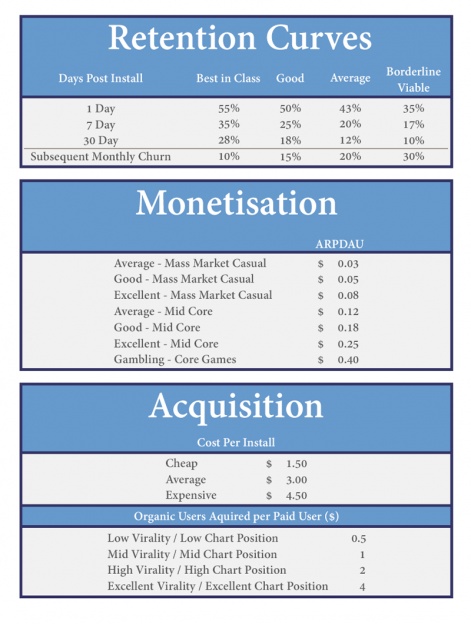Torulf Jernström is CEO of Finnish developer Tribeflame.
His blog is Pocket Philosopher.
This week is about how different features of the game will affect how long your players will stay and enjoy your game.
It's a rough sketch based on what we have learned from the dozen or so games that we have made so far.
First some basics (skip the next two paragraphs if you know what retention is):
Retention is the number of players coming back to your game after X days.
Say you get 1,000 people to download your game on the 31st of January. Those 1,000 people are called a "cohort". If 400 people from that cohort play on 1st of February, then your one-day retention is 40%.
People who play on the 2nd of February do not count towards the one-day retention (those would count towards the second-day retention), and people who downloaded on the 30th of January also do not count (those are another cohort).
Obviously, people from this cohort who play on the 7th of February count towards your 7-day retention, and people who play on the 28th of February count towards your 28-day retention.
The basic benchmark is:
- 1-day retention should be 40%,
- 7-day retention should be 20%, and
- 28-day retention 10%.
Some people use 30-day retention instead of 28-day, but ... you will get more stable data if you’re tracking exactly 4 weeks.
Some people use 30-day retention instead of 28-day, but as retention is also dependent on the day of the week, you will get more stable data if you're tracking exactly 4 weeks.
This is because people have more time for playing games during weekends - which means that someone who downloads on Friday is more likely to play on Saturday than someone who downloads on Sunday is likely to play on Monday.
The one-day retention varies by some 5 percentage points around weekends for our games.
For some more nuanced data, here's a cheat sheet for what Key Performance Indicators (KPIs) you should be aiming at with a mobile game. This is borrowed from a talk Ben Holmes from Index Ventures gave at Slush.
It's an incredibly useful summary.

According to this, our Benji Bananas game had a "Best in Class" 1-day retention, a good 7-day retention and a Less-than-viable 30-day retention.
And, the monetisation? Let's not talk about it! With some 75 million organic downloads, the CPI is just about 0, though.
This is all very easy to say, but incredibly hard to do in practise.
At Tribeflame, we have a philosophy of soft launching very, very early. As soon as we can somehow claim that it's a game, we start testing it.
This is different from what most companies call a soft launch. Pre-Alpha launch might better describe it.
At that point, there is basically just the core of the core loop. It's not pretty, and you cannot play it for a long time. It's also buggy, and players have no way of spending money in the game.
We start testing with an ugly core game. With this, we should be able to get a one-day retention at around 20%.
The feedback is always that the game has lots of huge issues, but that's fine at this point. Seeing the game improve and the metrics rise gives us a rough guide to how different features of the game influence retention.
As I already mentioned, we start testing with an ugly core game. With this, we should be able to get a one-day retention at around 20%. At times, we can even be below that, but should quite quickly improve it.
There is not yet enough content such as upgrades or levels to keep players in the game. Even 7 day retention is going to be way below 10% at this point. The game might also be confusing, since there is not yet a good tutorial.
Tutorial matters
Let's focus on the tutorial next.
This will, obviously, help us keep more players as we are not losing people simply because they get confused. Getting the tutorial in order should add to 1-3 day retention clearly.
Of course, it does not help that much later on - with the people who already understand how to play the game. However, there are the players who would have stayed for a very long time, had they only at the beginning understood how to play and had a good first impression.
(I'll write another article about tutorials and the first session later on.)
Another thing that helps early on is high production values. Pretty graphics, nice animations, etc. These things will help you get users more cheaply (lower your Cost Per Install - CPI).
There's a higher chance of featuring when your game looks amazing. People who go to your pages on Google Play or the App Store have a higher chance of downloading your game.
And it will help with virality - people are more likely to show their friends pretty things.
What it will not do is help you with long term retention. Someone who has played the game for hundreds of sessions is most likely almost blind to your graphics already. They take the look for granted, and focus on their long-term goals in the game.
To help you out here, you need a good meta game.
The meta game is about what happens between the game sessions. What is the player dreaming of achieving in between the daily grind of play sessions?
This is what will lift the tail of your retention curve. In short, a good meta game will set the player up with a long term goal - like build the perfect fortress, or assemble the perfect team or deck of cards. This long term goal is then divided into short steps - making the player feel clear progression every step of the way.
High production values will help with virality but not long term retention.
Draw up the glorious mountaintop that the player will conquer, make it look like it's closer than it really is, and then dangle a carrot in front of the player, and celebrate every single step they take on the way. Just one more turn and I will achieve that milestone, then one more to get to that one, etc. etc.
This is, for instance, why there is a huge amount of achievements and missions in many successful F2P games. Just telling people what to do next is one surprisingly good way of actually getting them to stay in the game and do it. It's also why upgrades to buildings, characters, vehicles, etc. are split into a lot of small steps.
I need to point out here that I, as a player of other companies' games, actually enjoy this experience of feeling like I'm close to my big goal, only to realise that the journey was longer than I first expected.
If I'm enjoying a good game (or a good book, TV series, etc.) I do not really want it to end.

Most people will advise you to focus on retention first, and use a great retention as a proxy for player's commitment to the game, and therefore as a signal for how much they are eventually willing to pay.
Some suggests going the other way and using early monetization (players paying in the first week) as a proxy for their commitment to the game, and eventually their long-term retention.
Probably either will work. However, there is some data to suggest that the later players start paying in the game, the more they will end up spending.
Also note that you would rather keep the players even if the do not pay, than lose them completely. Therefore, there should be no hard pay gates.
A free player is a free ad for the game. A walking, talking evangelist with a network of friends to influence.
A free player is a free ad for the game. A walking, talking evangelist with a network of friends to influence. In games where you play against others (PvP), the free players are also free content generators for the game company.
For a specific game, retention is likely to go down over time. For instance, in our Benji game, the one-day retention at launch was at 54%.
Now, a few years later, we are tracking 35-40% for one-day retention, with all numbers measured on organic users. Where you get your users will have a huge influence on the retention numbers - but that is also for another post.
The same trend has also been observed by others.
One last observation: it's likely better not to demand very deep concentration in mobile games. Deep concentration limits when people can play, which in turn makes it harder for them to form a habit around your game.
It's better to make the game playable with one eye while watching TV or your kids with the other eye. Console, VR and PC games will brag about how "immersive" they are.
On mobile, if you're immersed while waiting for the bus, you will miss the bus!





















